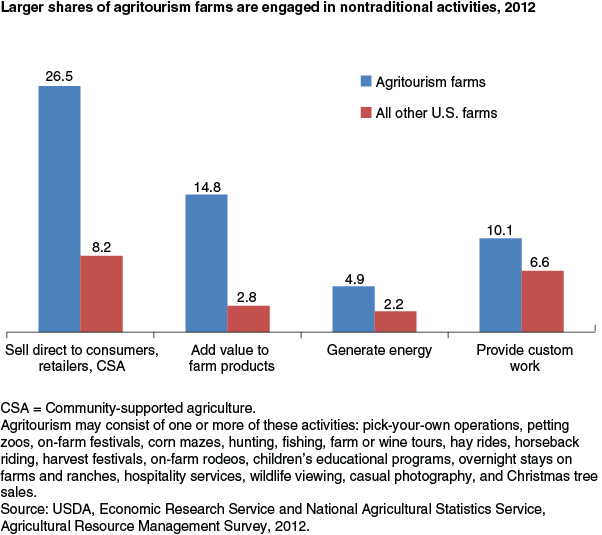Agritourism Farms Are More Diverse Than Other U.S. Farms
- by Faqir Bagi
- 10/6/2014
Agritourism involves attracting paying visitors to farms by offering farm tours, harvest festivals, hospitality services (such as bed and breakfast), petting zoos, and other attractions. Farms that provide agritourism services, referred to here as agritourism farms, also typically produce agricultural commodities and may provide a variety of other goods and services. Some agritourism farms engage in direct marketing of fresh foods to individual consumers and/or retailers, value-added agriculture (such as the production of beef jerky, fruit jams, jelly, preserves, cider, wine, and floral arrangements), generating renewable energy, and custom work (such as machine hire and hauling for other farms). All of these are considered non-traditional or niche activities that involve innovative uses of farm resources. Research suggests that education and connections to the broader economy are associated with farmers’ adoption of such activities, and agritourism farmers fit this profile. For example, based on the 2012 Agricultural Resource Management Survey (ARMS), compared with other farmers, agritourism farmers are more likely to have a college degree (45 percent versus 25 percent), use the Internet for business (78 percent versus 64 percent), and draw on paid management advice (72 percent versus 42 percent).
Aside from their diverse farm and nonfarm activities, agritourism farms vary greatly in size. Compared with other U.S. farms, agritourism farms are much larger on average (2,140 acres versus 387). But this difference is largely because the largest one-fifth of the agritourism farms operate very large ranches (8,740 acres on average) with relatively little cropland. They control 84 percent of farmland and more than half of woodland operated by all agritourism farms. As they have large areas of woodland (363 acres on average), hunting and fishing are likely agritourism activities on these farms, but some of them may operate dude ranches, provide overnight stays, or offer ranch tours, hay rides, or rodeos. The average size of the remaining four-fifths of agritourism farms (433 acres) is only a little larger than the average of all other U.S. farms. Furthermore, 20 percent of agritourism farms operate less than 50 acres.
Agritourism farms have quite diverse sources and amounts of income. These farms earn $713 million from agritourism, $349 million from sales of fresh foods directly to consumers, and $63 million from custom work. On average, agritourism farms obtain 20 percent of their gross farm income from niche activities, including 7.1 percent from agritourism. Average income from agritourism is $20,670, but 51 percent of these farms earn less than $5,000, and only 1 out of 7 earn over $25,000 from agritourism activities.
This article is drawn from:
- Bagi, F. & Reeder, R. (2012). Farm Activities Associated With Rural Development Initiatives. U.S. Department of Agriculture, Economic Research Service. ERR-134.
- 'Factors Affecting Farmer Participation in Agritourism'. (2012). Agriculture and Resource Economics Review, 41, Vol. 2, pp. 189-199.


